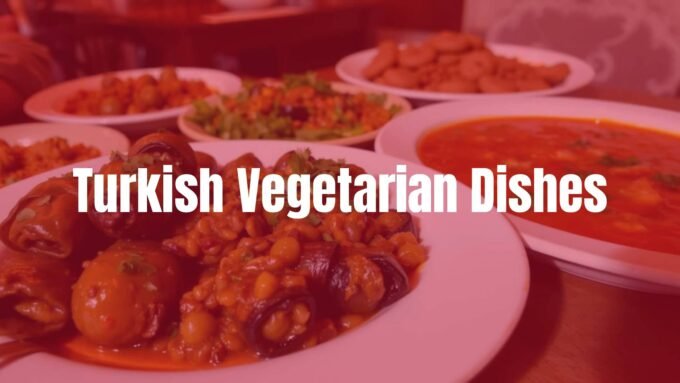Turkish dessert recipes include a wide range of sweet dishes enjoyed for their strong flavors, unique textures, and, often, their sweet syrups. Turkish desserts include more than just one type of sweet-they can be creamy puddings, thin and flaky pastries, chewy candies, or fruit-based treats. These desserts are an essential part of Turkish food culture and often play a big part in special occasions and everyday life. If you’re curious about what sets Turkish sweets apart, you’re about to discover a long tradition where each recipe reflects years of skill and a love of creating delicious treats.
These desserts go beyond simple sugary snacks. They show skill in preparation and a careful balance of flavors and textures. Classic desserts like baklava and Turkish delight, as well as lesser-known regional favorites, take you on a journey through Turkish food history. The recipes often turn basic ingredients into memorable, satisfying sweets and show just how creative Turkish cooks can be.

Main Features of Turkish Desserts
Turkish sweets stand out for several main reasons. To start, most traditional Turkish desserts use plenty of syrup, which makes them sweet and gives them a sticky texture. The syrup usually contains lemon juice to stop it from getting grainy. This syrup is important in many well-known desserts and is what creates the contrast between a crispy exterior and a soft, sweet inside.
Nuts, especially pistachios, walnuts, and sometimes hazelnuts, are essential in many recipes. They’re not just toppings but are often a main part of the dessert, giving flavor and crunch. The bright green color of Gaziantep pistachios is a sign of quality in many Turkish sweets. Texture is very important too, whether it’s the thin layers in flaky pastry, the creamy consistency in puddings, or the chewy effect in Turkish delight. Finally, Turkish desserts often have a deep, rich taste, achieved by cooking slowly and using aromatic spices.
| Key Feature | Description |
|---|---|
| Syrup | Used in many desserts for sweetness and stickiness |
| Nuts | Pistachios, walnuts, sometimes hazelnuts, add flavor and texture |
| Variety of textures | Layers and crunch, creaminess, or chewiness depending on the dessert |
| Deep flavors | Often achieved by slow-cooking and careful seasoning |
Common Ingredients in Turkish Sweets
- Semolina: Used in cakes and fried dough desserts.
- Flour: Basis for many cookies and pastries.
- Sugar: The main sweetener, often turned into syrup.
- Milk and Yogurt: Needed for puddings and some cakes.
- Nuts: Pistachios, walnuts, sometimes almonds or hazelnuts, used in large amounts.
- Fruits: Both fresh and dried, especially quince and pumpkin in seasonal treats.
- Spices: Cinnamon and clove add flavor.
- Butter: Often clarified butter, vital for crispy layered pastries.

What Makes Turkish Desserts Special?
Turkish desserts are special due to a mixture of history, local traditions, and a focus on sharing sweets during gatherings. Unlike some cuisines where appearance or extreme sweetness might come first, Turkish desserts try to keep a good balance of taste, texture, and a satisfying richness. People often enjoy these desserts with friends or family, commonly alongside Turkish tea or coffee.
Many recipes show creative uses of basic ingredients and unique techniques. For example, making pişmaniye involves pulling dough into fine strands, while baklava requires precise layering. These methods have been passed down for generations and reflect the importance of tradition in Turkish food.
History and Tradition
Turkish desserts have deep roots in the country’s history, with many dating back to the Ottoman Empire. The empire’s royal kitchens experimented with and perfected sweets, blending different culinary influences. Well-known desserts like baklava started as palace foods.
Sweets are not just for dessert-they are important in festivals, religious holidays, and daily traditions. For example, during Ramazan Bayramı, sharing sweets with neighbors is a must. Lokum (Turkish Delight) is often served with coffee to guests. These customs give Turkish desserts a strong place in everyday life and special events.

Regional Snacks and Specialties
Different parts of Turkey are famous for different desserts. While baklava can be found everywhere, its style or ingredients change by region. Gaziantep, for example, is famous for its pistachio baklava and skilled baklava makers. Hatay is known for a cheesy dessert called Künefe. Other areas use local ingredients, like hazelnuts in the Black Sea region and more fruit-based desserts on the Aegean coast. This variety means you can always find something new when exploring Turkish sweets.
Main Types of Turkish Desserts
Turkish desserts can be grouped into a few main types, making it easier to understand the range of options. From crispy pastries to soft puddings and fruit-based dishes, there’s something for every preference.
Phyllo Pastry and Nut Desserts
This is the category most people think of first, thanks to baklava. Layers of paper-thin phyllo dough are brushed with butter, filled with nuts, and baked, then soaked in syrup. Other treats in this group include şöbiyet (cream-filled baklava) and fıstıklı sarma (pistachio rolls).

Milk-Based Desserts
These desserts are extra creamy and comfortable, such as sütlaç (rice pudding) and tavuk göğsü (a unique pudding made with chicken breast). They use milk, cream, and sometimes rice or shredded chicken breast to create a smooth, lightly sweet texture, and are sometimes topped with cinnamon or nuts.
Fruit Desserts
Focusing on Turkey’s fruit harvest, these desserts are lighter and often less sweet. Kabak tatlisi (pumpkin dessert) and ayva tatlisi (quince dessert) are made by simmering fruit in syrup and serving with cream and nuts.
Desserts Soaked in Syrup
- Tulumba: Fried dough pipes crispy on the outside, soft inside, and soaked in syrup.
- Halka tatlisi: Turkish “churros.”
- Şekerpare: Semolina cookies soaked in syrup.
- Revani: Semolina cake soaked in syrup, stays extra moist.

Well-Known Turkish Desserts to Try
Trying Turkish desserts means you get to experience many time-honored recipes. Here are some of the best-known:
| Dessert | Main Ingredients | Description |
|---|---|---|
| Baklava | Phyllo, nuts, butter, syrup | Layered pastry filled with nuts and soaked in syrup; crisp and sweet |
| Künefe | Shredded phyllo, cheese, syrup | Hot dessert made with cheese and crispy pastry, topped with syrup |
| Tulumba | Choux dough, syrup | Fried dough pieces dipped in syrup, crispy outside and soft inside |
| Lokum (Turkish Delight) | Starch, sugar, flavorings, nuts | Chewy, flavored jelly pieces, often with nuts, dusted in powdered sugar |
| Sütlaç | Rice, milk, sugar | Oven-baked rice pudding with caramelized top, often served cold |
| Revani | Semolina, yogurt, syrup | Soft, sponge-like cake soaked in citrus syrup |
| Kabak Tatlisi | Pumpkin, sugar | Pumpkin simmered in syrup, served with nuts and sometimes cream |
| Ayva Tatlisi | Quince, sugar, clove | Quince simmered in syrup, served with cream and nuts |
| Tavuk Göğsü | Milk, sugar, chicken breast | Milk pudding with finely shredded chicken breast, very smooth and mild |
| Asure | Wheat, legumes, dried fruits, nuts | A thick, filling pudding enjoyed especially during Muharram |
| Pişmaniye | Flour, sugar, butter | Sweet, stringy candy similar to cotton candy but more crumbly |
| Fıstıklı Un Kurabiyesi | Butter, flour, sugar, pistachios | Shortbread cookies with pistachios, melts in your mouth |
How to Make Turkish Desserts: Step by Step
Making Turkish desserts at home can feel overwhelming, but with simple instructions, you can create them in your own kitchen.
Baklava: Construction and Baking
- Finely chop pistachios or walnuts.
- Layer thin sheets of phyllo dough, brushing each with clarified butter.
- Spread nuts over half the sheets, layer the rest on top with more butter.
- Cut into pieces before baking.
- Bake until golden. Pour cooled syrup over hot baklava immediately after baking and let it soak, ideally overnight.
Künefe: Cheese in Sweets
- Butter shredded pastry and layer into pan.
- Add unsalted cheese (like mozzarella or Hatay cheese).
- Top with more shredded pastry, then cook until crispy and the cheese is melted.
- Flip to brown both sides if needed.
- Pour hot syrup over and serve with ground nuts.
Sütlaç: Creamy Rice Pudding
- Boil rice in water until soft.
- Add milk (and heavy cream, if using), simmer on low, stirring often.
- Sweeten with sugar to taste.
- Pour into oven-safe dishes.
- Broil or bake until the top browns.
- Serve cold, sprinkle with cinnamon.
Lokum: Making Soft Turkish Delight
- Make sugar syrup and a separate cornstarch slurry.
- Slowly mix the slurry into the hot syrup.
- Cook until the mixture thickens to jelly-like texture (use thermometer if possible).
- Add flavorings and nuts as desired.
- Pour into a greased, dusted pan and let it set for several hours.
- Cut into small cubes and roll in powdered sugar and cornstarch to prevent sticking.
Tips for Making Turkish Desserts at Home
- Use good ingredients: Fresh, thin phyllo, high-quality butter and nuts, and fresh lemons for syrup are important for great results.
- Temperature is important: For most desserts, pour cold syrup on hot pastry or vice versa to stop them turning mushy.
- Be generous with butter: Not enough will result in dry pastries.
- Monitor baking times: Overbaking makes pastries too hard or puddings too dry.
- Let desserts rest: Many taste better after sitting overnight, letting flavors come together.
How to Serve and Enjoy Turkish Desserts
Serving tradition plays a big part in enjoying Turkish desserts. They are often eaten with Turkish tea or strong Turkish coffee. The bitterness of these drinks helps balance the sweetness of the desserts. Water is often served on the side to clear the palate.
Special occasions, like religious holidays and family gatherings, are perfect times to offer Turkish sweets. Baklava is popular for holidays, and lokum is a traditional treat to offer guests. Even simple cookies pair well with afternoon tea or coffee breaks.

Storing Turkish Desserts
- Phyllo and syrup desserts (baklava, revani): Store in airtight containers at room temperature. They last up to two weeks. Do not refrigerate, as this can make them soggy.
- Milk-based and fruit desserts (sütlaç, kabak tatlisi): Keep in the fridge. Best eaten in 3-5 days. Freezing is not recommended since it affects consistency.
Frequently Asked Questions About Turkish Desserts
Are they gluten-free or vegan?
Most Turkish desserts are not gluten-free or vegan since they use wheat flour, butter, and milk. Lokum sometimes contains gelatin. However, some adjustments are possible-for example, using gluten-free flour blends, plant-based butters, or agar-agar instead of gelatin. Always check ingredients if you have dietary needs.
Can I make Turkish desserts in advance?
Yes! Many, like baklava and revani, taste best after sitting a day or more. Syrupy pastries and Turkish delight store well in airtight containers for days or even weeks. Milk-based treats should be prepared no more than one or two days ahead and refrigerated.
How can I adapt recipes for special diets?
- Use gluten-free flour blends for cakes or cookies in place of wheat flour.
- Swap butter for plant-based margarine or oil for vegan options.
- Choose non-dairy milk (almond, soy, etc.) for puddings.
- Pick agar-agar for vegan Turkish delight instead of gelatin.
- Note that some desserts may taste or feel a bit different with substitutions, so a bit of trial and error may be needed.
















Leave a comment